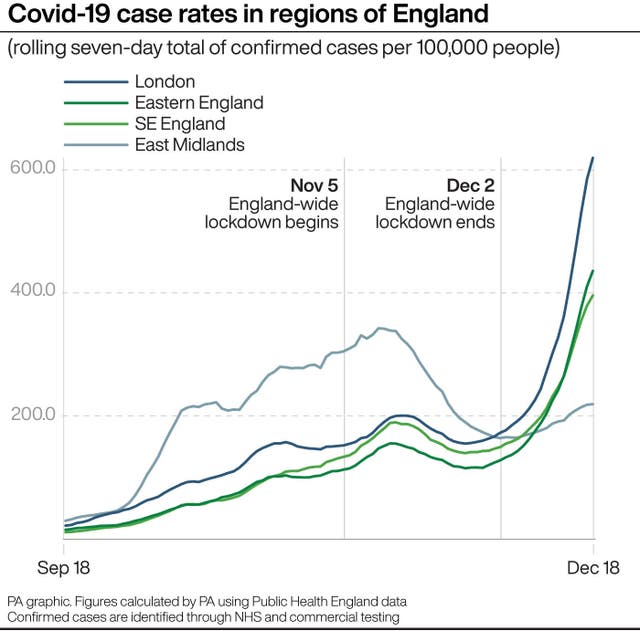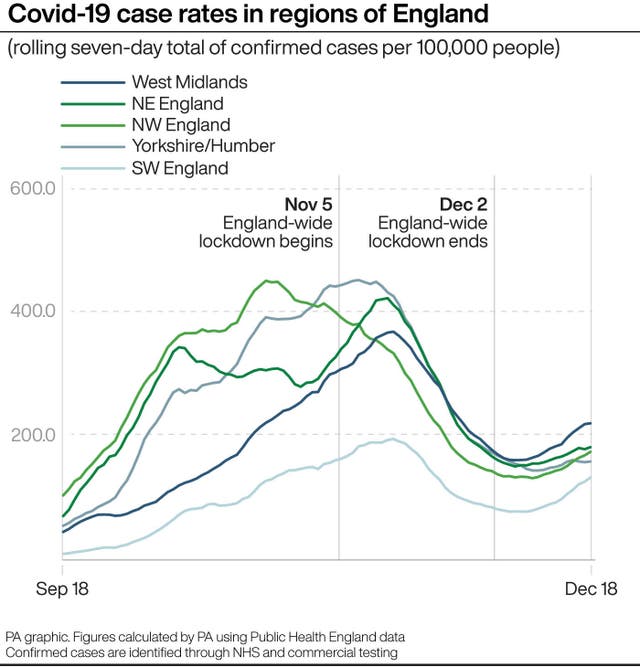England’s tier system explained as more changes are expected
Matt Hancock is due to address the Commons on Wednesday afternoon

Further changes to England’s tier system are expected to be announced on Wednesday, just days after millions of people came under harsher coronavirus restrictions on Boxing Day.
Matt Hancock is due to address the Commons on Wednesday afternoon, with more areas set to move into the lockdown-like Tier 4 due to rising case rates around the country.
Here is a summary of the Covid-19 tier levels ahead of Mr Hancock’s update.
– Tier 4
A total of 24 million people are living in Tier 4 – 43% of the population of England.
Some six million people were added to Tier 4 from Boxing Day in the following areas:
– Cambridgeshire: Cambridge, East Cambridgeshire, Fenland, Huntingdonshire and South Cambridgeshire
– East Sussex: Brighton & Hove, Eastbourne, Lewes and Wealden
– Essex: Colchester, Tendring and Uttlesford
– Hampshire: Basingstoke & Deane, East Hampshire, Eastleigh, Fareham, Hart, Rushmoor, Southampton, Test Valley and Winchester
– Norfolk: Breckland, Broadland, Great Yarmouth, King’s Lynn & West Norfolk, North Norfolk, Norwich, South Norfolk
– Oxfordshire: Cherwell, Oxford, South Oxfordshire, Vale of White Horse and West Oxfordshire
– Suffolk: Babergh, East Suffolk, Ipswich, Mid Suffolk and West Suffolk
– Surrey: Waverley
– West Sussex: Adur, Arun, Chichester, Crawley, Horsham, Mid Sussex and Worthing
These areas join Bedfordshire, Berkshire, Buckinghamshire, Peterborough in Cambridgeshire, Hastings and Rother in East Sussex, the rest of Essex, the rest of Hampshire, Hertfordshire, Kent, London and the rest of Surrey, which were already in Tier 4.

The main restrictions in Tier 4 are:
– No household mixing allowed, though one person can meet one other person outside in a public space
– All non-essential shops and businesses must close, including personal care and indoor entertainment
– Nobody can enter or leave Tier 4 areas
– Residents must not stay overnight away from home
– Tier 3
Some four million people moved to Tier 3 from December 26, bringing the Tier 3 total to 25 million people, or 44% of the population of England.
The areas that moved into Tier 3 from Boxing Day were:
– Bristol
– Cheshire: Cheshire East, Cheshire West & Chester and Warrington
– Gloucestershire: Cheltenham, Cotswold, Forest of Dean, Gloucester, Stroud and Tewkesbury
– Hampshire: Isle of Wight and New Forest
– Northamptonshire: Corby, Daventry, East Northamptonshire, Kettering, Northampton, South Northamptonshire and Wellingborough
– Somerset: Bath & North East Somerset, Mendip, North Somerset, Sedgemoor, Somerset West & Taunton and South Somerset
– Swindon
These areas joined the already Tier 3 Derbyshire, County Durham, South Gloucestershire, Greater Manchester, the Humber, Lancashire, Leicestershire, Lincolnshire, Northumberland, Nottinghamshire, South Yorkshire, Staffordshire, Tees Valley, Tyne & Wear, Warwickshire, the West Midlands metropolitan county and West Yorkshire.

The main restrictions in Tier 3 are:
– No household mixing allowed indoors or outdoors, except in parks and public gardens
– All hospitality is closed, except for takeaways and deliveries
– All accommodation and entertainment venues are closed
– Tier 2
The number of people living in Tier 2 currently stands at seven million, or 13% of the population of England.
Two areas were moved from Tier 1 to Tier 2 on Boxing Day: Cornwall and Herefordshire.
They joined Cumbria, Devon, the Liverpool City Region, North Yorkshire, Rutland, Shropshire, Wiltshire (not including Swindon), Worcestershire and York in Tier 2.

The main restrictions in Tier 2 are:
– No household mixing allowed indoors, but the “rule of six” applies outdoors
– Hospitality venues must close unless serving substantial meals with drinks
– Large sport and entertainment events are allowed but with a very limited audience
– Tier 1
Just 2,000 people are in Tier 1 as of December 26 – the population of the Isles of Scilly.
The main restrictions in Tier 1 are:
– The “rule of six” must apply indoors and outdoors
– There must be table service in hospitality venues, with last orders at 10pm and closing time at 11pm
– Large sporting and entertainment events are allowed but with a limited audience.





